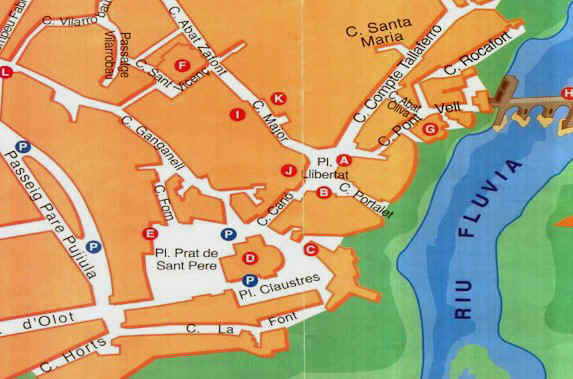·OVERVIEW
Municipality of “La Garrotxa”.
Population of 2000 inhabitants.
Area of 4.81 sq km.
The local government has 9 councellors
from the CiU (Convergencia i Unió) party.
The mayor: Lluís Guinó i Subirós
The main industry is the industrial sector
and services.
Market: Tuesday.
·ADDRESSES:
LOCAL GOVERNMENT
Plaça Llibertat Tel. 972 590 225
TOURIST OFFICE
Plaça Llibertat Tel. 972 591 240
CAP (Clinic)
Mas Plassa Tel. 972 590 032
POST OFFICE
St. Major Tel. 972 590 207
LOCAL RADIO STATION
St. Portalet Tel. 972 591 053
SCHOOL "SALVADOR VILARRASSA"
St. Pare Pujiula Tel. 972 590 109
NURSERY SCHOOL
St. Ganganell Tel. 972 591 213
LIBRARY
St. Major Tel. 972 590 761
PENSIONERS CLUB
St. Major Tel. 972 591 162
·FESTIVALS AND ACTS:
FESTIVAL OF “SANT VICENÇ”
Third Sunday in January
PROCESSION “DELS DOLORS”
Friday before Palm Sunday
EXHIBITION OF BLACKSMITHS
AND IRON ARTISTS
During Easter Week
MARKET AND
ANTIQUE DEALERS FAIR
Good Friday
EXHIBITION OF SARDANAS
The first Sunday in April
MEDIEVAL FESTIVAL
First Sunday in September
LOCAL FESTIVAL
“SANT PRIM I FELICIA”
Third weekend in September
REMIGIUS FLUVII
In the morning of Festival Sunday
(3rd Sunday in September)
RATAFIA FESTIVAL
1st Sunday in December
·HISTORY:
The name Besalú is derived from the
latin Bisuldunum,
meaning a fort on a
mountain between two rivers. It is also
the historical capital of the county of
“La Garrotxa”.
Its past stems from the origins of the
catalan nation. One key date is the year
894, when Besalú was converted to a
county with its own dynasty. The county
changed from “L’Empordà” to “El
Ripollès”.In the year 1111, Besalú lost its
independence, for historical reasons in
favor of the county of Barcelona.
Centuries later, Besalú started a
decadent period, worsened by the
redemptions, wars with the French and
carlists.
In 1966, Besalú was declared a site of
historical and artistic importance.
·MONUMENTS:
The monument is circled by the ancient
wall from the c. XII-XIV. Unfortunately only
parts of the original walls still exist today.
The urban configuration of the site is
almost identical to the original layout.
Without a doubt, the Medieval Bridge
is
the emblem of the town, of an angular
design with seven uneven arcs and two
towers. The
part of the town nearest to
the bridge there are many narrow streets
that belong to the ancient Jewish quarter.
It is in this area where you will find the
Miqvé, the purification baths, which date
from c. XII, and demonstrate the
presence of an important Jewish
community.
The street from the medieval bridge
leads to the Town Square “Plaça Major”,
a square whose arcades date from
c. XVI, and used to be the centre of the
medieval town. Important buildings are
the Local Government “Ajuntament”
dating from c. XVII, the Royal Curia
“Cúria Reial”, dating from c. XIV, and the
"Casa Tallaferro".
The street “Tallaferro” leads to the
entrance to the Castle precinct. Inside the
precinct there remains one of the towers
from the ancient County Castle, and the
apse of Saint Mary
“Santa Maria” that
dates from c. XI. Along with the street
“Portalet” these are the remains which
best retain the medieval appearance,
along with panoramic views of the
Romanic Bridge.
Leading up from the Main Street
“Carrer Major”, there are the
“Casa Romà” (c. XIV) and the parish
church of Saint Vincent “Sant Vicenç”
dating from c. XI-XII which has very
sculpturesque doors and windows.
Near to the Main Town Square, there is
the “Prat de Sant Pere”, wide and
spacious which used to be the Cemetery
of the Benedictine monastery of
Saint Peter
“Sant Pere”. Today there
only remains the three-nave church and
one apse, dating from the c. XI. Also
there is the small chapel of Saint James
“Sant Jaume” (c. XII) and the
“Casa Cornellà” (Llaudes)
dating from
the c. XII and which has a patio with three
galleries.
Behind the monastery there is the church of
the hospital of Saint Julia “Sant Julià”,
with
one nave and no apse, dating from c. XII,
and an outstanding entrance portal. |
  |